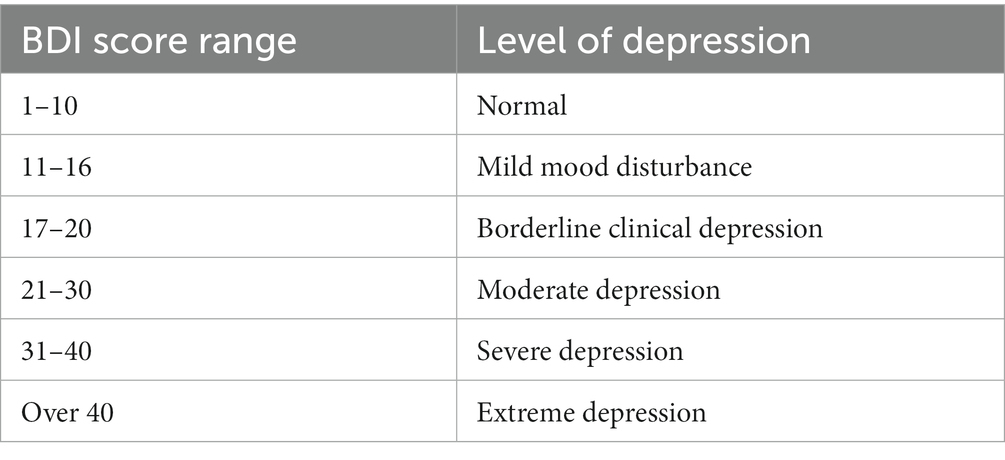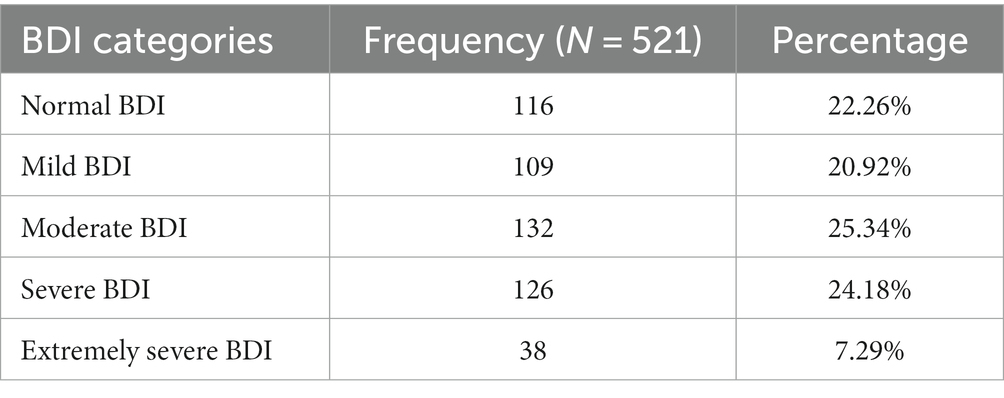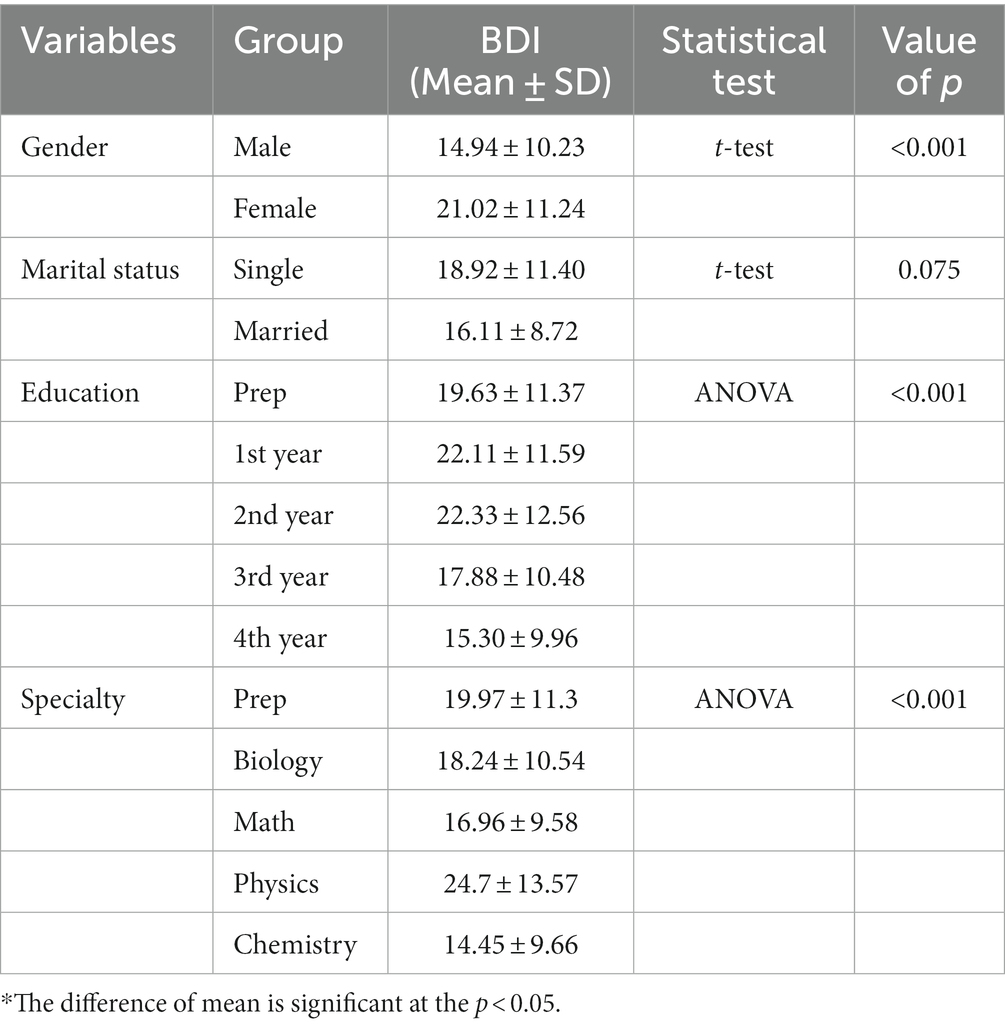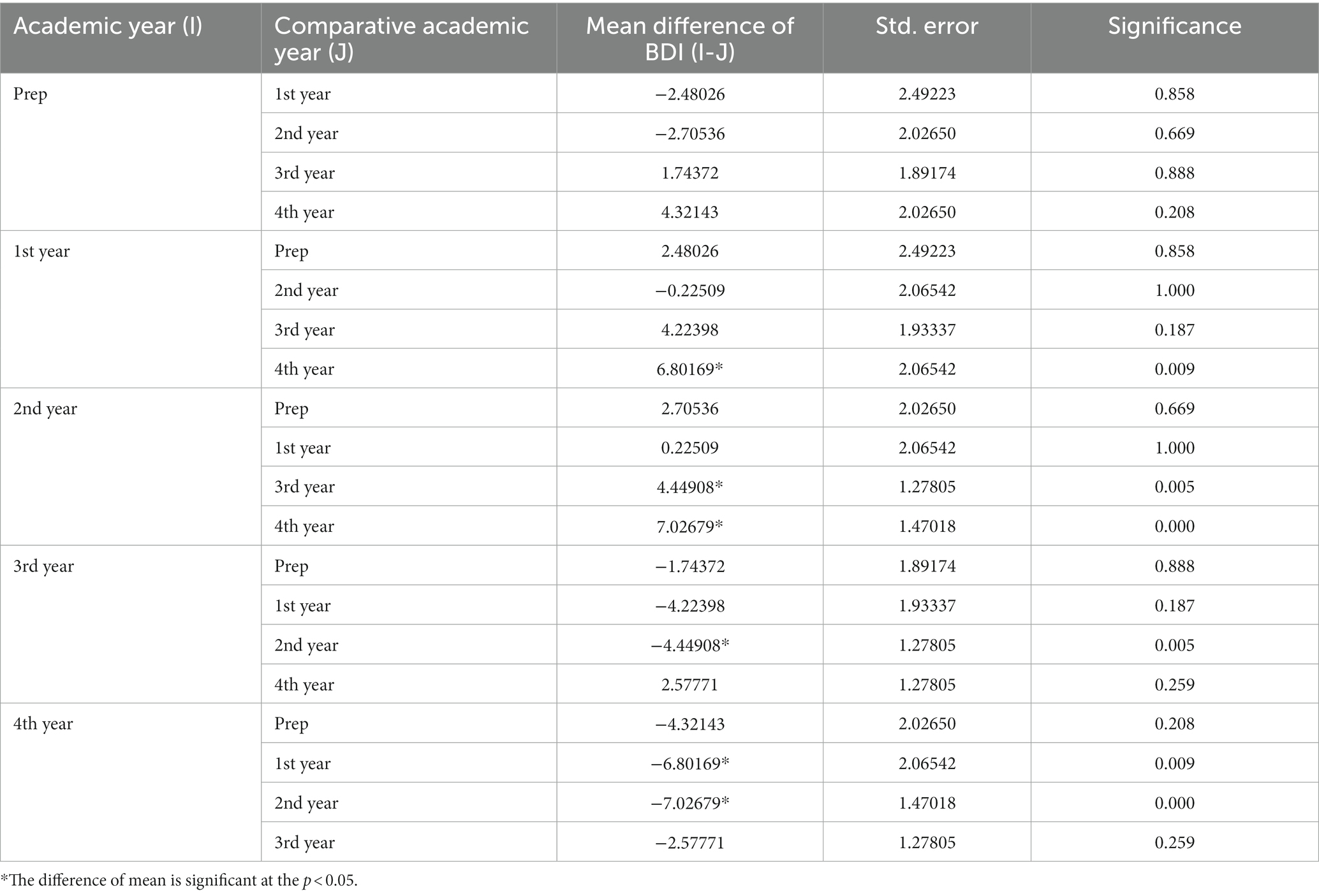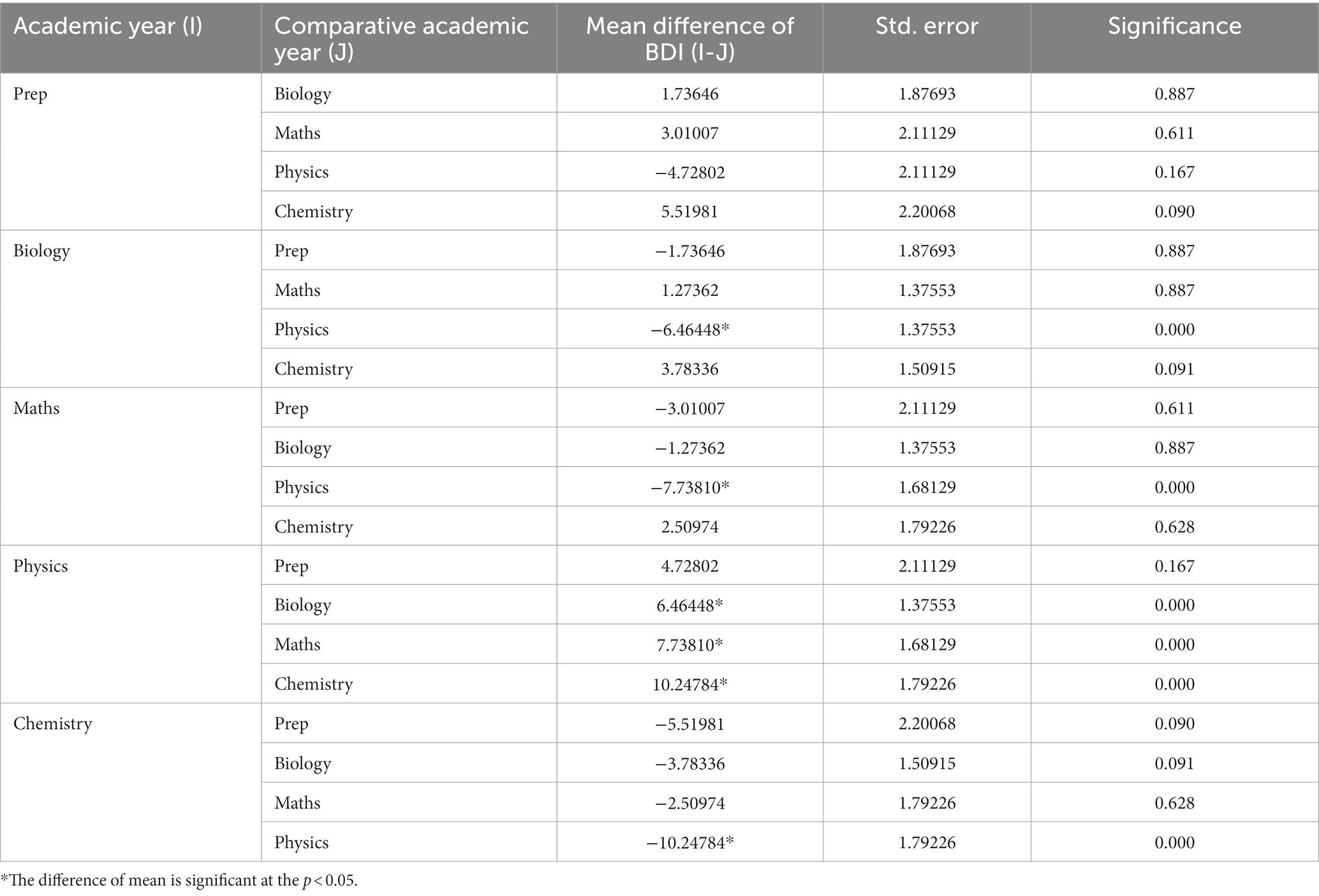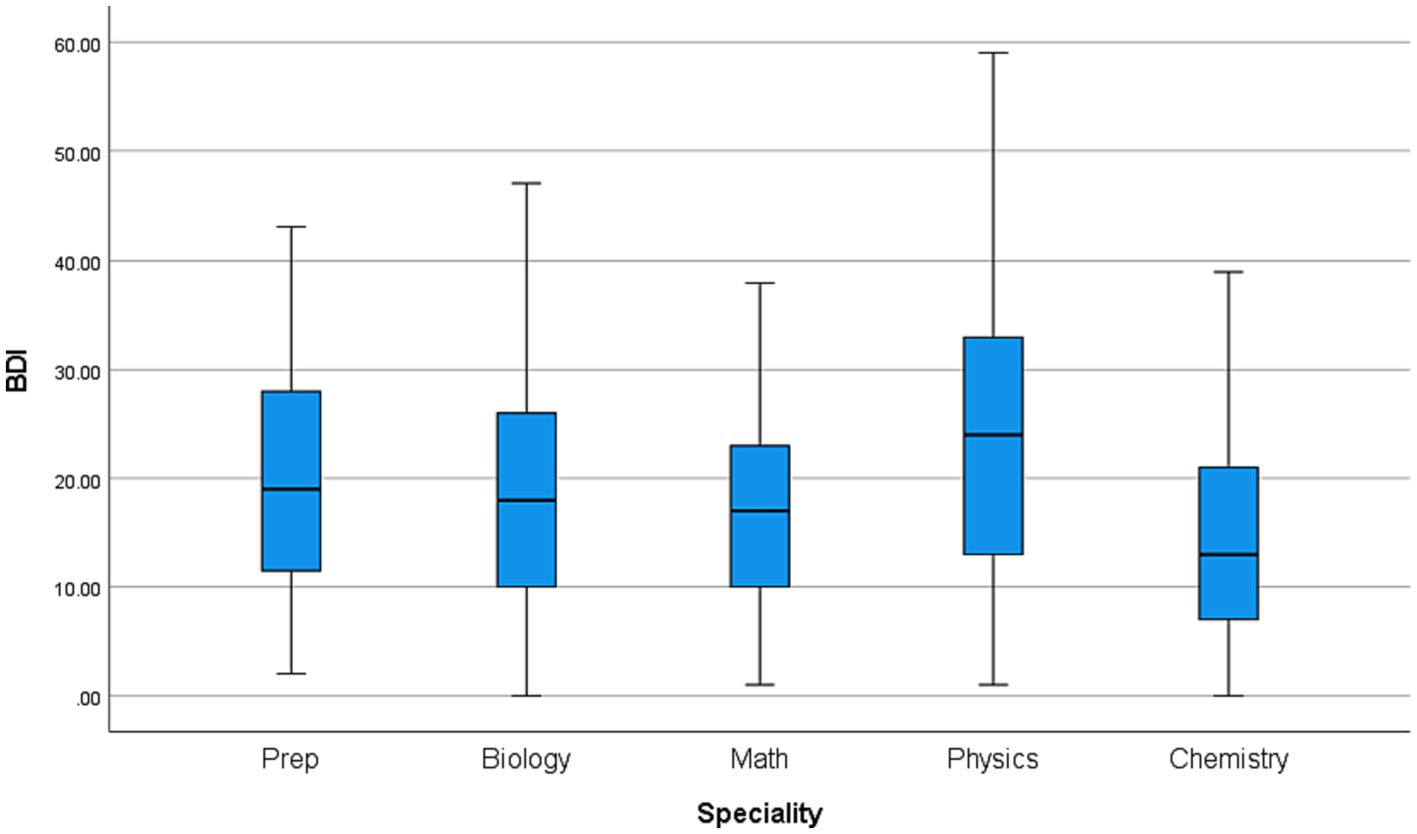- Imam Muhammad ibn Saud Islamic University, Riyadh, Saudi Arabia
Introduction: The present study aimed to examine the prevalence of depression among science students during the COVID-19 pandemic.
Methods: A survey-based study was conducted on 521 science students at Al Imam Mohammad Ibn Saud Islamic University, Riyadh, Saudi Arabia, using Beck’s Depression Inventory (BDI), during the course of the semester.
Results: Showed that the Most students were female (62.19%). Sadness symptoms were observed among 59.69% of the students. We found a 77.74% overall prevalence of depression among students. Most individuals reported moderate BDI (25.34%), but extremely severe BDI was also reported in 7.29% of individuals. The BDI scores were highly significantly correlated with gender, education, and field of specialty (< 0.001) based on different statistical tests. BDI scores were significantly associated with number of the demographic and academic variables (p < 0.05).
Discussion: The study found significant symptoms of depression among students who displayed characteristics of depression during the COVID-19 pandemic. Therefore, students should undergo psychological counseling during difficult pandemic periods to prevent depression and mental stress.
Introduction
One of the most prevalent and serious mental ailments affecting today’s youth is depression. It can last for at least two weeks and is characterized by a loss of interest and persistent sadness in things that people typically find enjoyable (1). Nearly 350 million individuals of all ages suffer from depression (2). The lifetime prevalence of anxiety and depression is currently estimated to be between 5 and 70% among adolescents and young adults worldwide (3). According to estimates, 18% of adolescents experience depressive symptoms, and both men and women are more likely to experience such symptoms as they age (4).
The most well-known disorders affect a variety of behaviors, such as concentration, motivation, self-worth assessment, anxiety, and depression (5). While training for their future jobs, university students make up a unique demographic group that must continually deal with and adapt to a variety of psychological problems stemming from both social and academic factors (6).
Numerous studies have suggested that students’ constant exposure to stressful situations, such as the burden of academic study in a broad field, parental pressure, fear of failure, difficulties in the job market, and susceptibility to various emotional outbursts, causes mental health problems (7, 8). Additionally, depression and anxiety have an impact on a student’s professional and personal attributes. Professional issues include lowered academic standards and integrity, a loss of empathy and morality, and an increase in medical blunders (8, 9).
This study was carried out during the time frame of the COVID-19 pandemic. To minimize the spread of COVID-19 in Saudi Arabia, the Ministry of Health (MOH) implemented a number of preventive strategies, including lockdowns. Ultimately, the majority of schools and universities were shut down, and online teaching techniques were adopted by the educational system. Numerous studies have examined the pandemic’s long- and short-term consequences on people’s psychological and social health (10). Some studies have shown that the COVID-19 pandemic seriously hampered people’s ability to behave normally and maintain their mental health (11, 12).
Therefore, this study explored the prevalence of depression based on Beck’s Depression Inventory (BDI) among science students studying at Imam Mohammad Ibn Saud Islamic University, Riyadh, Saudi Arabia, during the COVID-19 pandemic period. A study of a number from the associated factors with depression was carried out.
Materials and methods
Study setting and population
This cross-sectional study was conducted during the COVID-19 pandemic period in the years 2020–2021. The subjects were science students studying at the College of Science at Imam Muhammad Ibn Saud Islamic University, Riyadh, Kingdom of Saudi Arabia. Science students in this college are admitted directly after high school.
A cluster sampling method was used to select students. The questionnaires were sent online to the student leaders of each academic year, who disseminated the questionnaires to all students through different social media platforms. During this period, the students were given the opportunity to complete the questionnaire independently. A total of 521 students responded to the survey which represent more than 50% of the total number of College of Science students.
The ethical research committee of the Institutional Review Board (IRB) of Imam Mohammed Ibn Saud Islamic University (IMSIU), Riyadh, Saudi Arabia, approved this study. The students were informed of the purpose of the study, and their informed consent was later obtained.
Questionnaire
For this study, a questionnaire corresponding to the BDI model (13) was adopted. The questionnaire consisted of 21 items, and responses were scored using four options (0, 1, 2, and 3). For every question, 0 represented the lowest level of depression, whereas 3 represented the maximum level of depression. At the end of the questionnaire, the students encouraged to seek help if they have any related symptoms or thoughts. Also, students’ orientation activity was done in collaboration with academic affairs of the faculty of Science with students participation as peer education.
The interpretation of the level of depression based on the BDI score is as follows:
Data analysis
Data recorded in a predesigned form were entered into a Microsoft Excel spreadsheet. All entries were double-checked for possible typing errors. The demographic characteristics of the study sample were defined. Bivariate analysis was done to delineate factors associated with total and BDI scores using an independent samples t-test or analysis of variance (ANOVA), and multivariable liner regression as dependent variables. Multiple comparisons of BDI scores according to different academic years and specialties were conducted using Tukey’s post hoc test. Significance was set at p < 0.05. All calculations were done using IBM SPSS Statistics 25.
Results
Table 1 shows the demographic and academic characteristics of the 521 science students from Riyadh, most of whom were Saudi nationals. Most students were female (62.19%). The mean age was 21.78 ± 2.61 years. Since most of the individuals were students below 23 years of age, most were unmarried (93.09%). The maximum number of students was in the third year (42.03%), and most students belonged to a biology specialty (47.60%).
The shows the frequency distribution of BDI responses among the students. All BDI responses were gathered from the questionnaire used in this research. The main symptoms related to depression were: “I feel sad” (19.19%), “I am not particularly discouraged about the future” (52.98%), “I feel I have failed more than the average person” (64.88%), “I do not enjoy things the way I used to” (33.40%), “I feel guilty a good part of the time” (54.32%), “I feel I may be punished” (26.49%), “I am disappointed in myself” (25.72%), “I am critical of myself for my weaknesses or mistakes” (32.82%), “I have thoughts of killing myself, but I would not carry them out” (20.15%), “I cry more now than I used to” (16.51%), “I am slightly more irritated now than usual” (37.81%), “I am less interested in other people than I used to be” (33.59%), “I put off making decisions more than I used to” (31.29%), “I am worried that I am looking old or unattractive” (21.50%), “I have to push myself very hard to do anything” (33.01%), “I do not sleep as well as I used to” (48.56%), “I get tired more easily than I used to” (34.17%), “My appetite is not as good as it used to be” (27.83%), “I have lost more than ten pounds” (29.94%), “I am worried about physical problems like aches, pains, upset stomach, or constipation” (35.32%), and “I am less interested in sex than I used to be” (16.89%).
Table 2 shows the frequency distribution of the different categories of the BDI among the students. We found that most students reported moderate BDI (25.34%). Extremely severe BDI was also reported in 7.29% of the students.
Table 3 shows a comparison of the mean BDI scores with different demographic and academic data. The BDI scores were highly significant relationship with gender, education, and specialty based on different statistical tests (< 0.001). The BDI scores of females were found to be 1.40-fold of the male score.
Table 4 shows the results of the multiple linear regression analysis for the comparison of the BDI scores as dependent variables, with demographic and academic data as the independent variables. We found that BDI scores based on backward elimination of the multivariable regression were significantly associated only with age and gender variables (p < 0.05).

Table 4. Multiple linear regression analysis for comparison of BDI scores with demographic and academic data.
Table 5 shows the multiple comparisons of the BDI scores with different academic years assessed using Tukey’s post hoc test. The mean BDI score of the first-year students was significantly associated with the mean BDI score of the fourth-year students (p < 0.05), the mean BDI score of the second-year students was significantly associated with the mean BDI scores of the third- and fourth-year students (p < 0.05), the mean BDI score of the third-year students was significantly associated with the mean BDI score of the second-year students (p < 0.05), and the mean BDI score of the fourth-year students was significantly associated with the mean BDI scores of the first- and second-year students (p < 0.05).
Table 6 shows multiple comparisons of the BDI scores with different specialties analyzed using Tukey’s post hoc test. The mean BDI score of students in a biology specialty was significantly associated with the mean BDI score of physics students (p < 0.05); the mean BDI score of students in a math specialty was significantly associated with the mean BDI score of physics students (p < 0.05); the mean BDI score of physics students was significantly associated with the mean BDI scores of biology, math, and chemistry students (p < 0.05); and the mean BDI score of chemistry students was significantly associated with the mean BDI score of physics students (p < 0.05).
Figure 1 shows a box plot graph comparing the BDI scores among students of different academic years. Figure 2 shows a box plot graph comparing the BDI scores of different students in different specialties.
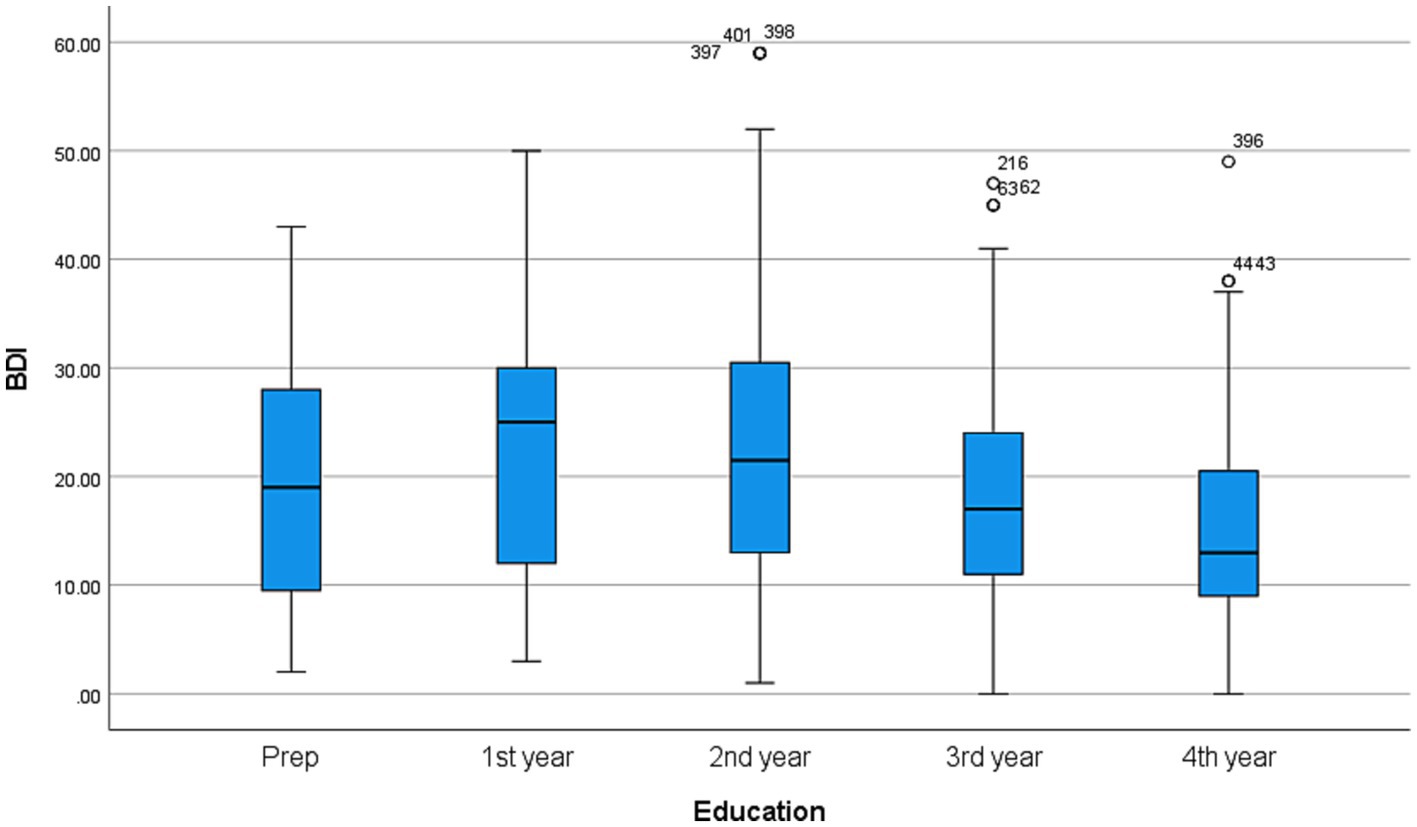
Figure 1. Box plot graph showing comparison of BDI scores with different academic year of the students.
Discussion
The present study reports the prevalence of depression among science students during the COVID-19 pandemic. The findings revealed many symptoms pertaining to adverse mental health, which may eventually lead to depression. The reported depressive symptoms may be implicated in the mental stress associated with the burden of study and the psychological stress of the COVID-19 pandemic. We found a 77.74% overall prevalence of depression among students, in which extremely severe depression was found in 7.29% of the students. BDI scores were significantly associated with age and gender.
Suicidal conduct and thoughts are significantly predicted by depressive symptoms (14, 15). Depressive symptoms are associated with poorer academic performance, a higher risk of dropping out, and adverse health impacts (5, 16–18). We discovered that there was a high percentage of depression among university students, as we calculated various levels of depression in accordance with the BDI questionnaire. The majority fell into the mild to severe depression groups (20.92, 25.34, 24.18, and 7.29% with light, moderate, severe, and extremely severe depression, respectively).
In agreement with our findings, earlier research conducted abroad has shown that the majority of students suffer from mild to moderate depression (19, 20). Our findings, which are consistent with earlier studies on depression among young students, show that students under the age of 22 experience higher levels of depression (21–23).
The pandemic is an additional factor that may lead to depression, as many students experience increased stress levels, anxiety, and depressive symptoms as a result of altered university teaching methods, technological worries about online courses, and future employment. All these concerns have been observed in universities around the world (24).
Furthermore, numerous studies have examined how students were psychologically affected by the COVID-19 pandemic (25). A study from the USA (26) found that the COVID-19 outbreak increased stress and anxiety levels in students by 71%, which is consistent with some of the findings from our study.
Similar studies conducted in Vietnam and China also support our findings. Vietnamese female students were more likely to be depressed than male students (27), and Chinese females had more anxiety than males during the COVID-19 pandemic period. More female students in our study displayed depressive symptoms. Thus, the mental health of students must be closely monitored.
Earlier studies suggest that students are not always aware of accessible psychological services (7) and cannot recognize that they need treatment (28). Therefore, it is important to promote mental health awareness among students and to educate them about the forms of psychological support provided by the medical services of a university (29, 30).
Conclusion
Significant symptoms of depression among science students during the COVID-19 pandemic were found in this study. The mental stress caused by the burden of study and the psychological stress resulting from the severe preventative measures imposed at the national level during the COVID-19 pandemic could have resulted in additional psychological stress and depressive symptoms. The implication of study findings is to review and promote the university students academic and psychological counseling with specific intervention plans during pandemics & disasters. The university needs to launch an awareness program to ensure that students are aware of the importance of mental health and to counter depression and mental stress among students, students should be encouraged to undergo psychological counseling during their study journey.
Study limitations
as cross-sectional study, our result does not proving causation, our sample represents about one Faculty student from the university in an online scale method during the time of pandemic. We recommended further studies with inclusion of representative samples from all university students.
Data availability statement
The raw data supporting the conclusions of this article will be made available by the authors, without undue reservation.
Ethics statement
This study was approved by institutional ethical committee, IMSIU (98-2021) from Imam Muhammad Ibn Saud Islamic University. The studies were conducted in accordance with the local legislation and institutional requirements. The participants provided their written informed consent to participate in this study.
Author contributions
MM: Writing – review & editing.
Funding
The author(s) declare that no financial support was received for the research, authorship, and/or publication of this article.
Acknowledgments
The authors would like to thank the national center for mental health promotion for their kind support.
Conflict of interest
The author declares that the research was conducted in the absence of any commercial or financial relationships that could be construed as a potential conflict of interest.
Publisher’s note
All claims expressed in this article are solely those of the authors and do not necessarily represent those of their affiliated organizations, or those of the publisher, the editors and the reviewers. Any product that may be evaluated in this article, or claim that may be made by its manufacturer, is not guaranteed or endorsed by the publisher.
References
1. WHO Depression. (2017). World Health Organization. Available at: http://www.who.int/mental_health/management/depression/en/ (Accessed March 23, 2022)
2. Pilania, M, Bairwa, M, Kumar, N, Khanna, P, and Kurana, H. Elderly depression in India: an emerging public health challenge. Australas Med J. (2013) 6:107–11. doi: 10.4066/AMJ.2013.1583
3. Sahoo, S, and Khess, CR. Prevalence of depression, anxiety, and stress among young male adults in India: a dimensional and categorical diagnoses-based study. J Nerv Ment Dis. (2010) 198:901–4. doi: 10.1097/NMD.0b013e3181fe75dc
4. Saluja, G, Iachan, R, Scheidt, PC, Overpeck, MD, Sun, W, and Giedd, JN. Prevalence of and risk factors for depressive symptoms among young adolescents. Arch Pediatr Adolesc Med. (2004) 158:760–5. doi: 10.1001/archpedi.158.8.760
5. Andrews, B, and Wilding, JM. The relation of depression and anxiety to life-stress and achievement in students. Br J Psychol. (2004) 95:509–21. doi: 10.1348/0007126042369802
6. Uehara, T, Takeuchi, K, Kubota, F, Oshima, K, and Ishikawa, O. Annual transition of major depressive episode in university students using a structured self-rating questionnaire. Asia Pac Psychiatry. (2010) 2:99–104. doi: 10.1111/j.1758-5872.2010.00063.x
7. Eisenberg, D, Gollust, SE, Golberstein, E, and Hefner, JL. Prevalence and correlates of depression, anxiety, and suicidality among university students. Am J Orthopsychiatry. (2007) 77:534–42. doi: 10.1037/0002-9432.77.4.534
8. Tabalipa, FDO, De Souza, MF, Pfützenreuter, G, Lima, VC, Traebert, E, and Traebert, J. Prevalence of anxiety and depression among medical students. Revista Brasileira De Educação Médica. (2015) 39:388–94. doi: 10.1590/1981-52712015v39n3e02662014
9. Dyrbye, LN, Thomas, MR, and Shanafelt, TD. Medical student distress: Causes, consequences, and proposed solutions. Mayo Clin Proc. (2005) 80:1613–22. doi: 10.4065/80.12.1613
10. Machado, DB, FJO, A, CSS, T, Rocha, AS, Castro-de-Araujo, LF, Singh, A, et al. Effects of COVID-19 on anxiety, depression and other mental health issues: a worldwide scope review. Res. Square. (2020). doi: 10.21203/rs.3.rs-58186/v1
11. Loades, ME, Chatburn, E, Higson-Sweeney, N, Reynolds, S, Shafran, R, Brigden, A, et al. Rapid systematic review: the impact of social isolation and loneliness on the mental health of children and adolescents in the context of COVID-19. J Am Acad Child Adolesc Psychiatry. (2020) 59:1218–39.e3. doi: 10.1016/j.jaac.2020.05.009
12. Gijzen, M, Shields-Zeeman, L, Kleinjan, M, Kroon, H, van der Roest, H, Bolier, L, et al. The bittersweet effects of COVID-19 on mental health: results of an online survey among a sample of the Dutch population five weeks after relaxation of lockdown restrictions. Int J Environ Res Public Health. (2020) 17:9073. doi: 10.3390/ijerph17239073
13. Beck, AT, Steer, RA, and Garbin, MG. Psychometric properties of the beck depression inventory: twenty-five years of evaluation. Clin Psychol Rev. (1988) 8:77–100. doi: 10.1016/0272-7358(88)90050-5
14. Cukrowicz, KC, Schlegel, EF, Smith, PN, Jacobs, MP, Van Orden, KA, Paukert, AL, et al. Suicide ideation among college students evidencing subclinical depression. J Am Coll Heal. (2011) 59:575–81. doi: 10.1080/07448481.2010.483710
15. Nam, B, Hilimire, MR, Jahn, D, Lehmann, M, and DeVylder, JE. Predictors of suicidal ideation among college students: a prospective cohort study. Soc Work Ment Health. (2018) 16:223–37. doi: 10.1080/15332985.2017.1380742
16. Hysenbegasi, A, Hass, SL, and Rowland, CR. The impact of depression on the academic productivity of university students. J Ment Health Policy Econ. (2005) 8:145–51.
17. Stallman, HM. Psychological distress in university students: a comparison with general population data. Aust Psychol. (2010) 45:249–57. doi: 10.1080/00050067.2010.482109
18. Dendle, C, Baulch, J, Pellicano, R, Hay, M, Lichtwark, I, Ayoub, S, et al. Medical student psychological distress and academic performance. Med Teach. (2018) 40:1257–63. doi: 10.1080/0142159X.2018.1427222
19. Waqas, A, Rehman, A, Malik, A, Muhammad, U, Khan, S, and Mahmood, N. Association of ego defense mechanisms with academic performance, anxiety and depression in medical students: a mixed methods study. Cureus. (2015) 7:1–7. doi: 10.7759/cureus.337
20. Singh, MM, Gupta, M, and Grover, S. Prevalence & factors associated with depression among school going adolescents in Chandigarh, North India. Indian J Med Res. (2017) 146:205–15. doi: 10.4103/ijmr.IJMR_1339_15
21. Piumatti, G. Motivation, health-related lifestyles and depression among university students: a longitudinal analysis. Psychiatry Res. (2017) 260:412–7.
22. Burdzovic, AJ, and Brunborg, GS. Depressive symptomatology among Norwegian adolescent boys and girls: the patient health Questionnaire-9 (PHQ-9) psychometric properties and correlates. Front Psychol. (2017) 8:887. doi: 10.3389/fpsyg.2017.00887
23. Ngasa, SN, Sama, CB, Dzekem, BS, Nforchu, KN, Tindong, M, Aroke, D, et al. Prevalence and factors associated with depression among medical students in Cameroon: a cross-sectional study. BMC Psychiatr. (2017) 17:216. doi: 10.1186/s12888-017-1382-3
24. Aristovnik, A, Ker Žiˇc, D, Ravšelj, D, Toma Ževiˇc, N, and Umek, L. Impacts of the COVID-19 pandemic on life of higher education students: a global perspective. Sustainability. (2020) 12:8438. doi: 10.3390/su12208438
25. Cao, W, Fang, Z, Hou, G, Han, M, Xu, X, Dong, J, et al. The psychological impact of the COVID-19 epidemic on college students in China. Psychiatry Res. (2020) 287:112934. doi: 10.1016/j.psychres.2020.112934
26. Son, C, Hegde, S, Smith, A, Wang, X, and Sasangohar, F. Effects of COVID-19 on college students’ mental health in the United States: interview survey study. J Med Internet Res. (2020) 22:e21279. doi: 10.2196/21279
27. Nguyen, DT, Wright, EP, Dedding, C, Pham, TT, and Bunders, J. Low self-esteem and its association with anxiety, depression, and suicidal ideation in Vietnamese secondary school students: a cross-sectional study. Front. Psychiatry. (2019) 10:698. doi: 10.3389/fpsyt.2019.00698
28. Thomas, SJ, Caputi, P, and Wilson, CJ. Specific attitudes which predict psychology students’ intentions to seek help for psychological distress. J Clin Psychol. (2013) 70:273–82. doi: 10.1002/jclp.22022
29. Henning, K, Ey, S, and Shaw, D. Perfectionism, the impostor phenomenon and psychological adjustment in medical, dental, nursing and pharmacy students. Med Educ. (1998) 32:456–64. doi: 10.1046/j.1365-2923.1998.00234.x
Keywords: depression, science students, Riyadh, Saudi Arabia, COVID-19
Citation: Mahmoud MA (2023) Prevalence of depression among Science students during the COVID-19 pandemic period in Riyadh, Saudi Arabia. Front. Psychiatry. 14:1286283. doi: 10.3389/fpsyt.2023.1286283
Edited by:
Fabrizio Stasolla, Giustino Fortunato University, ItalyReviewed by:
Mohamed Ghaith Al-Kuwari, Primary Health Care Corporation (PHCC), QatarLuis Manuel Mota de Sousa, Universidade Atlântica, Portugal
Copyright © 2023 Mahmoud. This is an open-access article distributed under the terms of the Creative Commons Attribution License (CC BY). The use, distribution or reproduction in other forums is permitted, provided the original author(s) and the copyright owner(s) are credited and that the original publication in this journal is cited, in accordance with accepted academic practice. No use, distribution or reproduction is permitted which does not comply with these terms.
*Correspondence: Mahmoud Abdulrahman Mahmoud, ZHJtaG1vZEBnbWFpbC5jb20=
 Mahmoud Abdulrahman Mahmoud
Mahmoud Abdulrahman Mahmoud